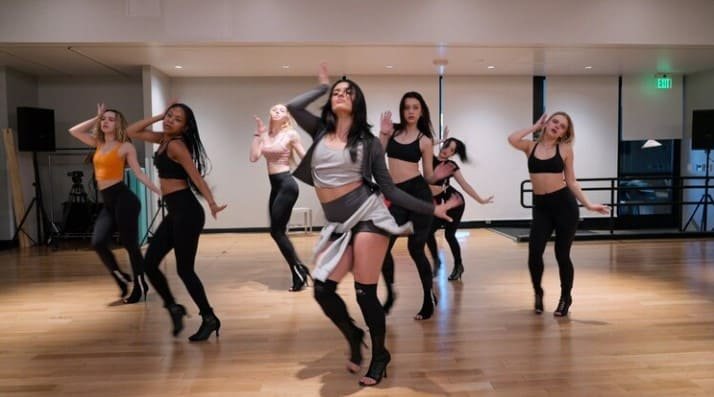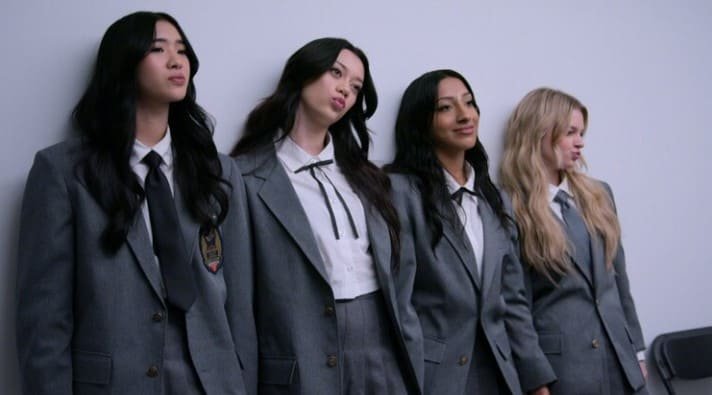Pop Star Academy: KATSEYE (Netflix) Story :-
Follows a group of exceptionally talented young women as they vie for a spot on the dream team: KATSEYE, the global girl group formed by K-pop powerhouse HYBE in collaboration with major US record label Geffen Records.
Pop Star Academy: KATSEYE (Netflix) Release Date, Trailor, Songs, Cast :-
| Release Date | 21 August 2024 |
| Language | English |
| Genre | Documentary |
| Episodes | 8 |
| Cast | Megan Skiendiel, Sophia Laforteza, Manon Bannerman, Daniela Azanzini, Jeong Yoon-Chae, Katseye, Harry Fincher |
| Director | Nadia Hallgren |
| Music | Louis Castle, James Bairian. |
| Producer | Rachel Libert, Andrew Fried, Sarina Roma, Lenzo Yoon |
| Production | HYBE, Boardwalk Pictures, Interscope Films |
| Certificate | 13+ |
Pop Star Academy: KATSEYE (Netflix) Review :-
When HYBE, a leading South Korean entertainment company, and Geffen Records, a major American label, joined forces to create what they called the world’s first “global girl group,” they set a one-year deadline to build pop’s next sensation from scratch. Their aim was to blend traditional K-pop training with an international roster of girls, targeting audiences in the U.S. and beyond. The process involved a rigorous, condensed version of the Korean entertainment industry’s notorious trainee programs, followed by a Korean-style survival show to finalize the group. The result: Katseye, a sextet from the U.S., Switzerland, South Korea, and the Philippines, who released their debut EP, SIS (Soft Is Strong), on Friday.
Given the scale, cost, and groundbreaking nature of the HYBExGeffen project, it was no surprise that the entire process was documented and turned into a docuseries. While the series claims to be a pioneering effort, it doesn’t break new ground but draws inspiration from iconic “making a band” shows of the 2000s, such as Making the Band, Pussycat Dolls Present: The Search for the Next Doll, and Rock School. Nonetheless, it successfully fills a gap in the current reality TV landscape.
In the traditional Korean entertainment industry, trainees start at a young age and undergo rigorous training for years, involving intense schedules of dance and vocal lessons, media training, etiquette, and language classes, all with the hope of eventually debuting. Central to this process is time, and the first half of Pop Star Academy focuses on the challenge of fitting this extensive training into a condensed timeline of under a year. The show outlines the strategy for scouting and compressing this process, resulting in 20 girls being selected to live together in Los Angeles for the inaugural class of HYBE America’s training and development program. During this period, the HYBExGeffen team evaluates the trainees periodically, ranking them based on their performance, attitude, and progress. Those who fall behind are sent home, while new trainees are introduced to maintain competitive spirit and address any gaps in the group’s dynamic, such as the need for a standout vocalist.
Pop Star Academy: KATSEYE (Netflix) Trailor :-
The final 20 contestants then participate in Dream Academy, a survival show where they compete in performance challenges judged by HYBExGeffen executives and voted on by fans to determine the final lineup of Katseye. This format not only involves the audience in shaping the group but also helps build a fan base before Katseye officially debuts.
This approach, deeply rooted in Korean entertainment practices, emphasizes “uniformity while celebrating individuality,” as described by the project’s creative director, Humberto Leon. This ethos is central to K-pop, where groups are crafted to balance a unified image with distinct individual roles, unlike Western pop groups that often present as a collection of diverse personalities, such as the bad boy, the goody two-shoes, the rebel, and the sweet one. The institutionalized training and development process, with its extensive infrastructure, is a hallmark of K-pop, distinguishing it from other labels that lack similar facilities. Consequently, the sound and style of the resulting group align with the upbeat, glossy aesthetics typical of K-pop’s leading girl groups.
The depiction of the process in Pop Star Academy closely mirrors earlier reality shows like The Search for the Next Doll and, most notably, Making the Band. In 1999, Lou Pearlman, the talent scout behind the Backstreet Boys and *NSYNC (and later infamous for running one of the largest Ponzi schemes in U.S. history), embarked on a nationwide quest to discover the next great boy band. This search led to the creation of O-Town, known for hits like “All or Nothing,” and was chronicled in Making the Band, which first aired on ABC in 2000 before moving to MTV. After several seasons with O-Town, Diddy took over from 2002–09, producing his own versions of the show—Making the Band 2, 3, and 4—which introduced successful acts like the girl group Danity Kane and the male R&B group Day26.
In 2007, the Pussycat Dolls launched a CW show to find a new member, who would later depart the group shortly after the show’s finale. This show contributed to the foundation for Pop Star Academy. These reality series, marked by intense competition and high stakes, often showcased participants vying for life-changing opportunities while balancing support and rivalry. Contestants underwent rigorous dance training with renowned choreographers like Laurieann Gibson, tackled challenging performances such as dancing in heels or singing live covers in front of judges, and faced grueling trials designed to test their limits.
Pop Star Academy builds on this legacy, though it features less personal drama. The series still offers an emotional roller coaster as the contestants push their physical and mental boundaries. Additionally, the show incorporates makeovers reminiscent of the dramatic transformations seen on America’s Next Top Model, further enhancing the contestants’ journey.
While Pop Star Academy echoes the competition shows of the 2000s, significant differences set it apart. Unlike the adult contestants of those earlier shows, Pop Star Academy features teenagers and navigates the complexities of international scouting and language barriers. It also emphasizes media training and public figure responsibilities, which were less of a focus in the past.
The most notable distinction is that Pop Star Academy combines elements of both a docuseries and a survival competition show, a blend not seen in earlier reality TV formats. This new iteration revives a niche from reality TV’s peak era, providing a fresh perspective on the industry. Beyond its entertainment value, the show offers an insightful look into the rigorous process of creating a pop group, highlighting the challenges and intricate details involved in forming a successful ensemble.
Pop Star Academy not only offers a glimpse into the world of pop music but also serves as a compelling comparison to its predecessors and highlights the contrast between Korean and Western media approaches. For HYBExGeffen, the show is a strategic move to build a solid fan base for their ambitious project and emphasize its unprecedented nature. While the concept isn’t entirely new—Korean entertainment has drawn inspiration from American and European models—the show showcases how Korean industries have refined these methodologies to achieve notable success.
In a nod to expanding their global influence, HYBE recently launched HYBE 2.0, an initiative aimed at integrating K-pop more deeply into the American music scene, led by the prominent Scooter Braun. Whether Katseye will meet the high expectations set by its creators remains to be seen, but Pop Star Academy undeniably marks the return of pop-industry reality TV with renewed vigor.






